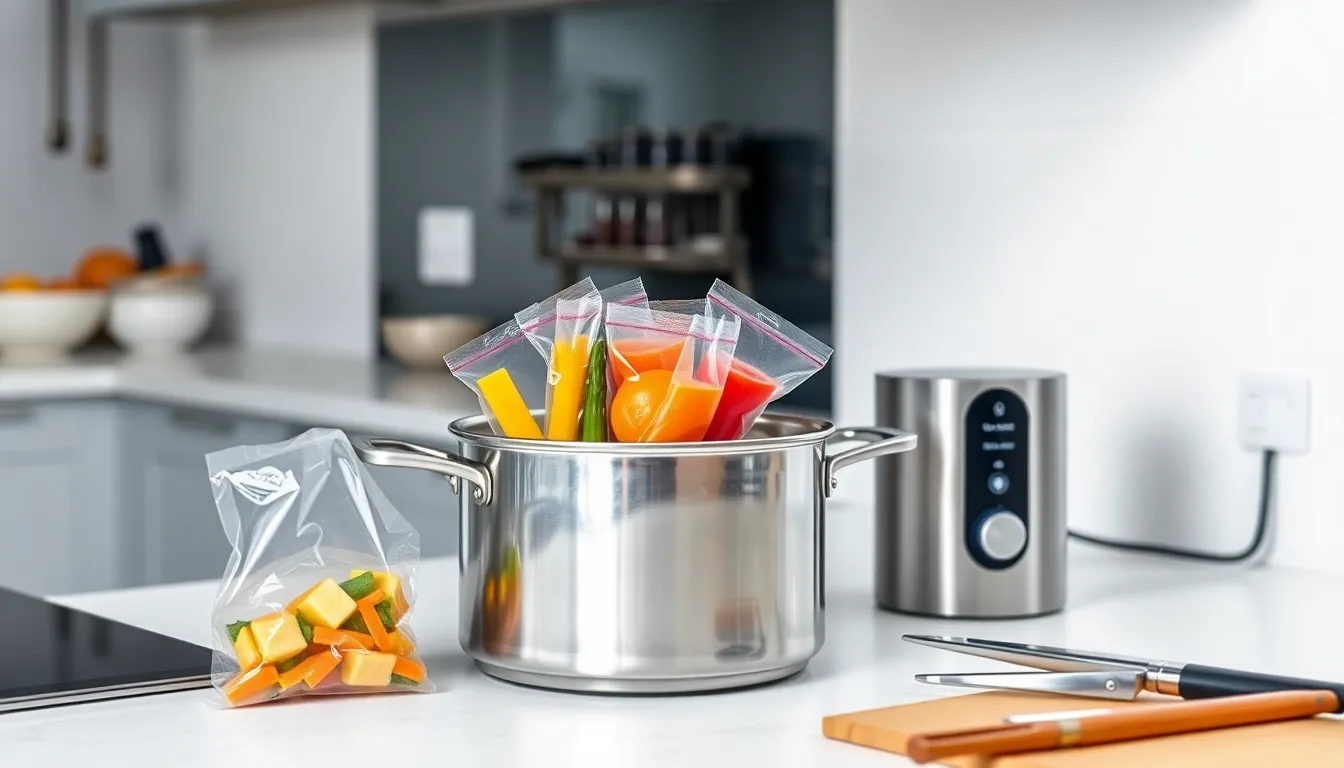In the world of cooking, mastering the basics is just the tip of the culinary iceberg. Once you’ve conquered the art of boiling water and flipping pancakes, it’s time to elevate your skills to the next level. Advanced cooking techniques can transform a simple meal into a gastronomic masterpiece, impressing dinner guests and satisfying even the pickiest of eaters.
Table of Contents
ToggleUnderstanding Advanced Cooking Techniques
Advanced cooking techniques transform basic dishes into culinary masterpieces. Chefs often rely on these methods to refine flavors, textures, and presentation.
What Are Advanced Cooking Techniques?
Advanced cooking techniques refer to specialized methods that enhance food preparation. Examples include sous vide, sous vide refers to vacuum-sealing food and cooking it at precise temperatures. Techniques like molecular gastronomy utilize science to create innovative textures and flavors. Fermentation introduces beneficial bacteria to preserve and enhance taste. Knowledge of these skills can elevate any kitchen experience.
Importance of Mastering These Techniques
Mastering advanced techniques significantly improves culinary skills. Such expertise allows for creativity in dish creation, inspiring chefs to experiment with flavors and presentations. Enhanced techniques elevate meal quality, impressing guests and enriching dining experiences. Understanding these methods contributes to professional growth, providing chefs with a competitive edge. Mastery also fosters confidence, enabling experimentation and innovation in the kitchen.
Sous Vide Cooking

Sous vide is a precise cooking method that involves vacuum-sealing food and cooking it at controlled temperatures. This technique allows for consistent results and enhances flavors.
Benefits of Sous Vide
Sous vide offers numerous advantages that elevate culinary creations. First, it provides precise temperature control, ensuring food is cooked evenly throughout. Additionally, this method retains moisture, resulting in tender and juicy textures. Flavor infusion occurs as food cooks in its juices, enhancing taste significantly. Nutrient retention is another key benefit; cooking this way preserves vitamins and minerals found in foods. Simplifying meal preparation, sous vide enables chefs to prepare ingredients ahead of time without compromising quality. Impressively, it delivers restaurant-quality dishes at home with minimal effort.
Equipment Needed for Sous Vide
Essential tools streamline sous vide cooking. A vacuum sealer is crucial for sealing food in bags, preventing water from entering during cooking. Immersion circulators heat water to specific temperatures and circulate it for even cooking. Food-safe bags, like heavy-duty zip-top or dedicated sous vide bags, ensure durability and safety while cooking. Furthermore, a large pot or container holds water and food, creating a stable cooking environment. Optional accessories, like sous vide lid and rack, enhance efficiency by minimizing evaporation and securing bags in place. Choosing quality equipment maximizes the sous vide experience, leading to consistently impressive results.
Molecular Gastronomy
Molecular gastronomy combines cooking with science to create innovative dishes. This technique focuses on understanding physical and chemical transformations during cooking, leading to unexpected textures and flavors.
Key Principles of Molecular Gastronomy
Understanding the key principles of molecular gastronomy enhances culinary creativity. Techniques revolve around the transformation of ingredients, such as foaming, spherification, and gelification. Chefs utilize precise temperatures and pressure to manipulate food properties, resulting in unique textures. Emphasizing sensory experiences, molecular gastronomy aims to surprise diners with innovative presentations. Additionally, it explores the impact of pairing flavors, providing a deeper appreciation of taste.
Popular Molecular Gastronomy Techniques
Popular techniques in molecular gastronomy include spherification and emulsification. Spherification creates caviar-like spheres that burst with flavor, enhancing presentation and surprise. Emulsification produces stable mixtures of oil and water, commonly seen in sauces and dressings. Techniques like sous-vide cooking align closely with molecular gastronomy through precise temperature control. Additionally, foam creation, which introduces air into mixtures, adds lightness to dishes. Each method contributes to an imaginative culinary experience, tantalizing guests with adventures for the palate.
Smoking and Wood Infusion
Smoking infuses food with rich flavors, creating depth in culinary creations. Techniques involve exposing food to smoke from burning or smoldering materials, typically wood.
Methods of Smoking Food
Cold smoking preserves and flavors food without cooking it. Chefs often use this method for items like fish or cheeses. Hot smoking, on the other hand, cooks food while infusing flavor. This technique works well for meats and vegetables. Chef’s can also employ smoke roasting, which combines roasting and smoking in one process, providing a unique texture and taste.
Types of Wood for Smoking
Various wood types offer distinct flavors for smoking. Hickory delivers a strong, robust flavor, perfect for hearty meats such as pork and beef. Mesquite provides an intense smoky taste, often preferred for grilling. Applewood, known for its subtle sweetness, suits poultry and pork, giving a slight fruity essence. Cherry wood provides a mild and slightly sweet flavor, ideal for smoking fruits and vegetables. Selecting the right wood enhances the overall dish, contributing to a memorable dining experience.
Fermentation
Fermentation plays a crucial role in advanced cooking techniques. This process uses beneficial bacteria and yeast to transform food into flavorful, preserved, and nutrient-rich products. Chefs can harness fermentation’s magic to enhance taste and introduce unique textures. By mastering fermentation, culinary enthusiasts unlock a world of flavors, promoting creativity and experimentation.
Importance of Fermentation in Cooking
Fermentation offers numerous benefits in the culinary world. It preserves food through the action of microbes, extending shelf life. This method enriches flavors, producing distinctive tastes that elevate dishes. Fermented foods also provide health advantages, supporting digestion and enhancing gut health. Chefs appreciate fermentation for its ability to deepen complexity in dishes, making them more appealing to discerning diners. Additionally, this technique fosters creativity, encouraging chefs to explore innovative flavor combinations.
Common Fermented Foods
Numerous foods undergo fermentation, each with unique characteristics. Yogurt, produced through bacterial fermentation, boasts a creamy texture and tangy flavor. Sauerkraut, made from fermented cabbage, offers a crunchy texture and sharp taste. Kimchi, a popular Korean dish, combines fermented vegetables and spices, delivering bold flavors. Sourdough bread relies on natural fermentation for its distinctive tang and airy structure. Miso, a fermented soybean paste, adds umami to broths and marinades. Additionally, kombucha, a fermented tea, provides a refreshing, slightly effervescent beverage option. These common fermented foods serve as versatile ingredients, enhancing a wide range of culinary creations.
Emulsification Techniques
Emulsification is a crucial technique in advanced cooking. It creates stable mixtures of two normally unmixable liquids, typically oil and water.
Types of Emulsions
Emulsions fall into two primary categories: temporary and permanent. Temporary emulsions, such as vinaigrettes, require vigorous mixing but often separate over time. Permanent emulsions, like mayonnaise and hollandaise, utilize emulsifiers to maintain stability. Emulsifiers, such as egg yolks or mustard, help keep the mixture intact. Additionally, oil-in-water emulsions commonly feature in sauces, while water-in-oil emulsions appear in butter spreads and creamy dressings. Each type influences texture and flavor in dishes.
Tips for Successful Emulsifications
Successful emulsifications demand specific techniques and conditions. Begin by slowly incorporating oil into the liquid while whisking vigorously. Use a stable base, like an egg yolk or mustard, to help emulsify the mixture. Maintain a consistent temperature to prevent separation. Gradually adding ingredients while whisking prevents breaking. Implementing a food processor simplifies the process, allowing for smoother results. Finally, ensure ingredients are at room temperature for optimal emulsification, enhancing the mixture’s overall stability.
Embracing advanced cooking techniques opens up a world of culinary possibilities. Chefs can transform everyday meals into extraordinary experiences that impress and delight. By incorporating methods like sous vide, molecular gastronomy, smoking, and fermentation, they not only refine their skills but also enhance the flavors and presentation of their dishes.
These techniques encourage creativity and experimentation, allowing chefs to push the boundaries of traditional cooking. Mastering these skills not only elevates the dining experience but also builds confidence in the kitchen. Whether preparing a casual meal or hosting an elegant dinner, advanced cooking techniques can make all the difference in creating memorable dishes that leave a lasting impression.





